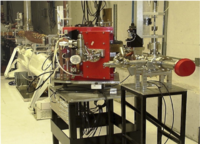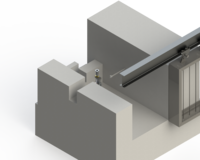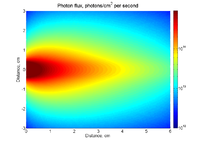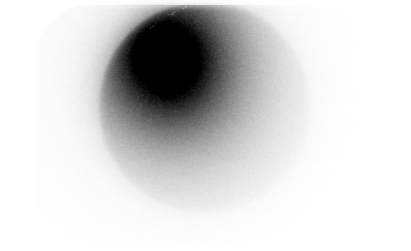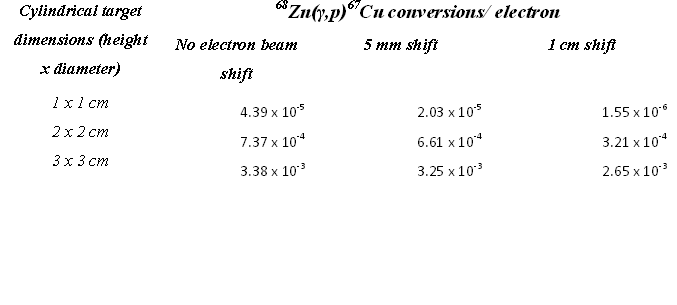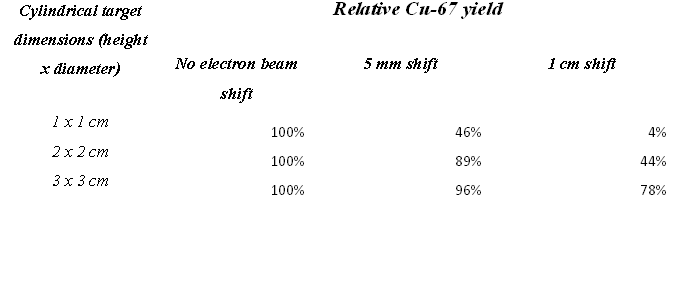Difference between revisions of "TF IsotopeTracers"
| (131 intermediate revisions by the same user not shown) | |||
| Line 1: | Line 1: | ||
=MRI RFP= | =MRI RFP= | ||
| + | |||
| + | |||
| + | |||
| + | http://www.nsf.gov/funding/pgm_summ.jsp?pims_id=6186 | ||
| + | |||
| + | "2) Development of New Instrumentation, Analytical Techniques or Software that will extend current research and research training capabilities in the Earth sciences. The maximum request is $1,000,000;" | ||
| + | |||
http://www.nsf.gov/pubs/2013/nsf13517/nsf13517.htm | http://www.nsf.gov/pubs/2013/nsf13517/nsf13517.htm | ||
| + | |||
'''Highlights'''. | '''Highlights'''. | ||
| Line 19: | Line 27: | ||
=Proposal= | =Proposal= | ||
| + | |||
| + | [[NSF-MRI_2013]] | ||
| + | |||
| + | |||
| + | The proposal will ask for a robot to move the sample from the trolley system into a pig because the holder may be activated as well as the sample. | ||
| + | |||
| + | A row of CVD detectors will be used to scan the photon field at low electron currents which will reduce the maximum photon flux to 10^9. | ||
| + | |||
| + | An array of CVD detector will be place downstream of the sample to monitor the flux as the electron current is increased to maximize the photon flux on the target. The position of the target can also be monitored with respect to the photon flux field as the field decreases to to the target absorbing photons. | ||
| + | |||
==Purpose== | ==Purpose== | ||
| − | In June of 2012, the Idaho Accelerator Center received a grant from the state of Idaho as part of the Idaho Global Entrepreneurial Mission (IGEM) program. One of the proposed objectives was to research use of an electron accelerator to | + | In June of 2012, the Idaho Accelerator Center received a grant from the state of Idaho as part of the Idaho Global Entrepreneurial Mission (IGEM) program. One of the proposed objectives was to research the use of an electron accelerator to produce Copper isotopes for medical diagnostic procedures. Preliminary results of the work sponsored by this research have indicated that the production of Copper isotopes strongly depends on the alignment of the incident radiation to the sample. While a two cm sample size may produce the highest number of isotopes per volume, a missalignment of more than a centimeter may reduce the amount of isotopes produced by a factor of at least two. A strong need now exists for a system to monitor the spatial distribution of the photons used to irradiate the samples. Based on these results, we propose the development of an irradiation instrument, that qualifies for the MRI category "Track 2", to be used for isotope production and PAA analysis. |
| − | The proposed instrument will be composed of a photon beam monitoring system and a sample conveyor. Support from this MRI will be used to construct the photon monitoring system. Matching support from the IGEM project will be used for the sample conveyor system. The conveyor, commonly referred to as a | + | The proposed instrument will be composed of a photon beam monitoring system and a sample conveyor. Support from this MRI will be used to construct the photon monitoring system. Matching support from the IGEM project will be used for the sample conveyor system. The conveyor, commonly referred to as a rabbit, will transport samples into the irradiation region and then to a shielded container (lead pig) after irradiation. The transportation system is a necessity due to the high activity isotopes that may be produced. When used as an instrument for PAA, the transportation system will eliminate the step of shutting the accelerator off in order to change to the control sample thereby risking a change in the experimental conditions whose uniformity is essential for meaningful measurements. Once calibrated, the photon monitoring system would allow users to irradiate sample with a known amount of radiation. |
| + | |||
| + | The proposed instruments ability to enhance the production of copper isotopes for medical diagnostic tests is only one potential use. Isotope production in the US is a $$$ busines.. | ||
| + | |||
| + | |||
| + | Paragraph of the instruments impact on the production of isotopes. | ||
| + | |||
| + | Using the instrument for PAA and the large potential user base. | ||
| + | |||
| + | |||
| + | The University of Missouri's Research Reactor is a current producer of medical isotopes with a total operating budget o | ||
==Talking points== | ==Talking points== | ||
| Line 38: | Line 66: | ||
5.) Device will train accelerator physicists, nuclear chemists, ... | 5.) Device will train accelerator physicists, nuclear chemists, ... | ||
| + | What is the difference between time-like and spacelike Feynman diagram | ||
| + | |||
| + | |||
| + | ==Minnesota Lunar Simulant== | ||
| + | |||
| + | PAA was used to determine the trace elements present in the Minnessota Lunar Simulant 1 (MLS-1) material synthesized to approximate soil sample 10084 from the Apollo 11 mare material. Synthesized materials, like MLS-1, were produced to aide in the development of next generation lunar technologies for future lunar missions. Workshops were held to identify and define lunar regolith simulant materials for this purpose. Figure XXX quantifies PAA's ability to measure the trace elements of this material and contrasts those measurements with | ||
| + | |||
| + | In 2005, the Marshal Space Flight Center and the Johnson Space Center held a workshop to identify and define lunar regolith simulant materials that would be needed for the development of next generation lunar technologies to support future missions. This workshop was a follow up to a 1989 workshop that led to the development the lunar simulants MLS-1 and JSC-1. The PAA survey of this material was compared with Three moon dust simulant samples were irradiate for a PPA analysis and compared to a reference study. | ||
| + | |||
| + | [\ref L. Sibille, "Lunar Regolith Simulant Materials, Recommendations for Standardization, Production, and Usage", NASA TP, 2005] | ||
| + | |||
| + | http://isru.msfc.nasa.gov/lib/Documents/PDF%20Files/LRSM_docs/LRSM_Abstract_Book.pdf | ||
| + | |||
| + | Table 4.3B (pg 4-13) in the reference below has the trace element data for MLS-1 as attribute to Tucker and Setzer (1991) | ||
| + | http://isru.msfc.nasa.gov/lib/Documents/PDF%20Files/Final_LSRM_Report_12-9-05.pdf | ||
| − | + | D. Tucker and A. Setzer, "Differential Thermal Analysis of Lunar Soil Simulant", NASA Technical Memorandum TM-103563, 1991 | |
| − | + | http://ntrs.nasa.gov/archive/nasa/casi.ntrs.nasa.gov/19920006733_1992006733.pdf | |
| − | |||
| − | + | [[File:MLS-1_PAAresults.png | 200 px]] | |
| + | [[File:MLS-1_PAAresults.xmgrac.txt]] | ||
| + | [[File:MLS-1_PAAresults_Land.png | 200 px]] | ||
| − | |||
| + | ==Evironmental Dust == | ||
| − | + | Instrumental analytical methods are preferable in studying sub -milligram quantities of airborne particulates | |
| − | + | collected in dust filters. The multi-step analytical procedure used in treating samples through chemical separation can be | |
| + | quite complicated. Further, due to the minute masses of the airborne particulates collected on filters, such chemical | ||
| + | treatment can easily lead to significant levels of contamination. Radio-analytical techniques, and in particular, activation | ||
| + | analysis methods offer a far cleaner alternative. Activation methods require minimal sample preparation and provide | ||
| + | sufficient sensitivity for detecting the vast majority of the elements throughout the periodic table. In this paper, we will | ||
| + | give a general overview of the technique of photon activation analysis. We will show that by activating dust particles | ||
| + | with 10- to 30-MeV bremsstrahlung photons, we can ascertain their elemental composition. The samples are embedded | ||
| + | in dust-collection filters and are irradiated “as is” by these photons. The radioactivity of the photonuclear reaction | ||
| + | products is measured with appropriate spectrometers and the respective analytes are quantified using multi -component | ||
| + | calibration materials. We shall provide specific examples of identifying the elemental components of airborne dust | ||
| + | particles and volcanic ash by making use of bremsstrah lung photons from an electron linear accelerator at the Idaho | ||
| + | Accelerator Center in Pocatello, Idaho. | ||
| − | + | [[File:PhilsCaariPaper_2013.pdf]] | |
| − | | | + | |
| − | | | + | =Equipment= |
| − | + | ||
| − | + | ||
| − | + | ==WHite room pictures== | |
| − | + | ||
| − | + | [[File:JackAccelPhoto_02072013.png | 200 px]] | |
| − | + | ||
| − | + | [[File:WhiteRoomEndStation_02072013.png | 200 px]] | |
| − | + | ||
| − | + | ==Detectors== | |
| − | + | ||
| − | + | CVD diamond | |
| − | + | ||
| − | + | Erich Griesmayer | |
| − | + | ||
| − | + | http://www.cividec.at | |
| − | + | http://www.cividec.at/#products.html | |
| + | |||
| + | Prof. Dr. Erich Griesmayer | ||
| + | CIVIDEC Instrumentation GmbH | ||
| + | Schottengasse 3A/1/41 | ||
| + | A - 1010 Wien | ||
| + | Mobile: +43 664 1066840 | ||
| + | Fax: +43 1 9223619 | ||
| + | www.cividec.at | ||
| + | |||
| + | == BPMs== | ||
| + | |||
| + | Bergoz Instrumentation: | ||
| + | |||
| + | S-BPM = $4080 Euros | ||
| + | S-BPM-FEFA = $1260 Euros | ||
| + | |||
| + | the other accessories are also desired | ||
| + | |||
| + | [[File:Bergoz_BPM_PriceList_2012.pdf]] | ||
| + | |||
| + | ==Permanent magnet== | ||
| + | |||
| + | === Off the shelf=== | ||
| + | A M-25 5 kGauss permanent magnet with a footprint of 4" x 3" could be placed between the radiator and the isotope target on Jack. | ||
| + | |||
| + | http://www.mmr-tech.com/comp_electromagnets.php | ||
| + | |||
| + | The gap is 0.75" so it to would need to go in the vacuum. We would need to determine how much the beam spot blows up after leaving the converter and how high the photon flux is in the sample region after the 3" distance is taken up by the magnet. | ||
| + | |||
| + | ===Custom=== | ||
| + | |||
| + | The vendor below has stated that they have the ability to design a permanent magnet to our specification. | ||
| + | |||
| + | http://www.duramag.com/request-a-quote.html | ||
| + | |||
| + | The above vendor needs a CAD drawing showing the dimensions of a magnet that would work for isotope production on Jack in order to provide a quote. | ||
| + | |||
| + | need large quantity orders, not interested now in one custom magnet. Didn't think 1" face was possible. | ||
| + | |||
| + | jima@duramag.com | ||
| + | |||
| + | == Transport system samples== | ||
| + | |||
| + | http://www.intellitrak.com/Products.htm | ||
| + | |||
| + | http://www.intellitrak.com/Products-500.htm | ||
| + | |||
| + | |||
| + | http://www.asi.com/auto-industrial/overhead-conveyors/monorail.php | ||
| + | |||
| + | |||
| + | http://www.asi.com/bulk-material/ | ||
=References= | =References= | ||
| Line 118: | Line 225: | ||
http://www.npl.co.uk/upload/pdf/091104_nuc_galbiati.pdf | http://www.npl.co.uk/upload/pdf/091104_nuc_galbiati.pdf | ||
| + | |||
| + | ===Medical isotopes=== | ||
| + | |||
| + | Market report forcasting -> 2015 | ||
| + | |||
| + | http://www.prnewswire.com/news-releases/global-nuclear-medicine-medical-isotopesradioisotopesradiopharmaceuticals-market-in-petspect-imaging--therapy---competitive-landscape-current-trends--forecasts-2010-2015-139005529.html | ||
| + | |||
| + | 2013 DOE Medical Isotope program budget and info | ||
| + | |||
| + | http://science.energy.gov/~/media/budget/pdf/sc-budget-request-to-congress/fy-2013/Cong_Budget_2013_IsoptopeProductionandDistributionProgramFunding.pdf | ||
| + | |||
| + | |||
| + | 2010 Talk on Future Isotope needs in medicine and industry | ||
| + | |||
| + | http://www.nscl.msu.edu/~mantica/radio-frib/runde-acsboston.pdf | ||
| + | |||
| + | Need Mo-99, Tc-99m, I-131, I-125, Cu-67, At-211, Ac-225, Bi-213, Am-241, Gd-148, Sr-90, Pm-147 | ||
| + | |||
| + | |||
| + | A big isotope supplier is Eckert & Ziegler | ||
| + | |||
| + | http://www.ezag.com/fileadmin/ezag/user-uploads/pdf/analyses-englisch/concord_e_01.pdf | ||
| + | |||
| + | 2009 Medical Isotope industry & trade study | ||
| + | |||
| + | http://www.usitc.gov/publications/332/ITS-1.pdf | ||
| + | |||
| + | ===Fracking=== | ||
| + | |||
| + | http://www.shalegas.energy.gov/resources/111811_final_report.pdf | ||
| + | |||
| + | |||
| + | Earth Justice | ||
| + | |||
| + | http://earthjustice.org/features/campaigns/fracking-across-the-united-states | ||
| + | |||
| + | http://www.drillingmaps.com/fracking.html#.UQq-QKUlZ6I | ||
| + | |||
| + | |||
| + | Injection of a wide range of radioactive tracers in solid, liquid or gaseous forms,<ref name="NRC"/> is often used to determine the injection profile and location of fractures created by hydraulic fracturing.<ref name="Reis iodine" /> The radiotracer is chosen to have readily detectable radiation, appropriate chemical properties, and a half life and toxicity level that will minimize initial and residual contamination.<ref name="IAEA 2003" /> | ||
| + | |||
| + | The isotopes, [[Manganese-56]], [[Sodium-24]], [[Technetium-99m]], [[Isotopes of silver|Silver-110m]], [[Argon-41]], and [[Xenon-133]] are used extensively in the oil industry because they are easily identified and measured.<ref name="IAEA 2003" /> Also [[Antimony-124]], [[Bromine-82]], [[Iodine-125]], [[Iodine-131]], [[Iridium-192]], and [[Scandium-46]] are used.<ref name="NRC"/> | ||
| + | |||
| + | In the United States radionuclides maximum amounts per injection are controlled by the [[Nuclear Regulatory Commission|United States Nuclear Regulatory Commission (NRC)]].<ref name="NRC"/> For example, Iodine-131, gas form, 100 millicuries total, not to exceed 20 millicuries per injection; Iodine-131, liquid form, 50 millicuries total, not to exceed 10 millicuries per injection; Iridium-192, "Labeled" frac sand, 200 millicuries total, not to exceed 15 millicuries per injection; Silver-110m, liquid form, 200 millicuries total, not to exceed 20 millicuries per injection.<ref name="NRC"/> | ||
| + | |||
| + | |||
| + | Na-24 is used for fracking as well... They are making it on site by (n,gamma) on Na-23, using neutron generators. Initial concentration of Na-24 is 0,24 mCi, volume of the solution is 2-3 m3; activity per volume is 0.08-0.12 mCi/m3. | ||
| + | |||
| + | ===Geology=== | ||
| + | |||
| + | 2011 paper on PAA for environmental analysis | ||
| + | |||
| + | http://www.rrp.infim.ro/2011_63_2/art03Oprea.pdf | ||
| + | |||
| + | A 1988 paper measuring Flourine using PAA | ||
| + | |||
| + | |||
| + | http://www.tandfonline.com/doi/abs/10.1080/10256018808624007#preview | ||
| + | |||
| + | 2007 paper studies PAA,NAA,PGA techniques for measuring Halogen in Geological samples | ||
| + | |||
| + | http://www.ncbi.nlm.nih.gov/pubmed/17878588 | ||
| + | |||
| + | 2007 comparison of PAA and NAA in geology | ||
| + | |||
| + | http://www.ingentaconnect.com/content/klu/jrnc/2007/00000271/00000003/00000311?crawler=true | ||
| + | |||
| + | |||
| + | 1994 segebade article on optimizing PAA for environmental analysis | ||
| + | |||
| + | http://www.ncbi.nlm.nih.gov/pubmed/7710821 | ||
| + | |||
| + | |||
| + | 2009 measuring Sr/Ca in teeth can be useful for biology and archaeology | ||
| + | |||
| + | http://www.researchgate.net/publication/24241220_Using_medical_accelerators_and_photon_activation_to_determine_SrCa_concentration_ratios_in_teeth | ||
| + | |||
| + | |||
| + | ====Potential collaborators==== | ||
| + | |||
| + | Alberto E. Patiño Douce | ||
| + | |||
| + | http://www.gly.uga.edu/patinoA/ | ||
| + | |||
| + | Sune Nielsen | ||
| + | |||
| + | http://www.whoi.edu/profile.do?id=snielsen ( http://nsf.gov/awardsearch/showAward?AWD_ID=1119373) | ||
| + | |||
| + | ==Artificially-produced Isotope List== | ||
| + | |||
| + | Jeff H. Shelton | ||
| + | Isotope Business Office (IBO) | ||
| + | National Isotope Development Center (NIDC) | ||
| + | Telephone: (865) 576-6401 | ||
| + | E-mail: EF6 or sheltonjh@ornl.gov | ||
| + | |||
| + | |||
| + | |||
| + | |||
| + | |||
| + | Cobalt-60, Lanthanum-140, Scandium-46, Silver-110m, Gold-198: | ||
| + | Used together in blast furnaces to determine resident times and to quantify yields to measure the furnace performance. | ||
| + | |||
| + | |||
| + | |||
| + | |||
| + | cross section data base | ||
| + | |||
| + | http://cdfe.sinp.msu.ru/services/ | ||
| + | |||
| + | http://www.jcprg.org/exfor/ | ||
| + | |||
| + | |||
| + | http://www-nds.iaea.org/photonuclear/ | ||
| + | |||
| + | http://www-nds.iaea.org/photonuclear/app-b2.pdf | ||
| + | |||
| + | ===Industrial=== | ||
| + | |||
| + | ;Using targets with natural isotope abundance larger than 20 % | ||
| + | |||
| + | {| border="1" |cellpadding="20" cellspacing="0 | ||
| + | |- | ||
| + | | Isotope || Production Reaction|| Target nat. Abund || X sect || Use | ||
| + | |- | ||
| + | |Cesium-137||<math>{138 \atop\; }Ba (\gamma,p){137 \atop \; }Cs</math> || 72% ||Used for radiotracer technique for identification of sources of soil erosion and deposition, in density and fill height level switches. | ||
| + | |- | ||
| + | |Cobalt-60 || <math>{61\atop\; }Ni (\gamma,p){60 \atop \; }Co</math>|| 1 % ||Used for gamma sterilisation, industrial radiography, density and fill height switches. | ||
| + | |- | ||
| + | | Gold-198 || <math>{199 \atop\; }Hg (\gamma,p){198 \atop \; }Au</math> || 16.9% || Used to study sewage and liquid waste movements, as well as tracing factory waste causing ocean pollution, and to trace sand movement in river beds and ocean floors. | ||
| + | |- | ||
| + | |Iodine-131 ||<math>{132 \atop\; }Ze (\gamma,p){131 \atop \; }I</math>|| 27% ||adioactive tracer isotopes are injected with hydraulic fracturing fluid to determine the injection profile and location of fractures created by hydraulic fracturing | ||
| + | |- | ||
| + | | Iridium-192 ||<math>{193 \atop\; }Ir (\gamma,n){192 \atop \; }Ir</math>|| 63% || Fracking ,Used in gamma radiography to locate flaws in metal components. | ||
| + | |- | ||
| + | |Zinc-65|| <math>{66 \atop\; }Zn (\gamma,n){65 \atop \; }Zn</math> || 28% || [http://www-nds.iaea.org/photonuclear/app-b2.pdf pg 56] || Used to predict the behaviour of heavy metal components in effluents from mining waste water. | ||
| + | |- | ||
| + | |Scandium-47|| <math>{48 \atop\; }Ti (\gamma,p){47 \atop \; }Sc</math> || 74% || [http://www-nds.iaea.org/photonuclear/app-b2.pdf pg 133] | ||
| + | |- | ||
| + | |} | ||
| + | |||
| + | |- | ||
| + | | Tl-201 || || Medical Thalilum is most common substitute for Tc | ||
| + | |- | ||
| + | | Cu-67 || <math>{68 \atop\; }Zn (\gamma,p){67 \atop \; }Cu</math> || 19% || | ||
| + | |- | ||
| + | |||
| + | Rh-99 | ||
| + | |||
| + | Ti-44 | ||
| + | |||
| + | Pd-100 | ||
| + | |||
| + | Ag-111 | ||
| + | |||
| + | Hf-181 | ||
| + | |||
| + | Bi-204 | ||
| + | |||
| + | |||
| + | |||
| + | Cs-131, Silver-110, Indium-111, Ga-67, Bromine-77, Fl-18, O-15, Al-26, N-13, Scandium-47, Ba-133 | ||
| + | |||
| + | Tt-195 -> Ir-194 | ||
| + | |||
| + | {| border="1" |cellpadding="20" cellspacing="0 | ||
| + | |- | ||
| + | | Isotope || Production Reaction|| Use | ||
| + | |- | ||
| + | | Am-241 || || Used in backscatter gauges, smoke detectors, fill height detectors and in measuring ash content of coal. | ||
| + | |- | ||
| + | |Cesium-137||<math>{138 \atop\; }Ba (\gamma,p){137 \atop \; }Cs</math> (72%) ||Used for radiotracer technique for identification of sources of soil erosion and deposition, in density and fill height level switches. | ||
| + | |- | ||
| + | |Chromium 57|| ||Used to label sand to study coastal erosion. | ||
| + | |- | ||
| + | |Cobalt-60 || <math>{58 \atop\; }Ni (\gamma,p){192 \atop \; }Co</math>|| Used for gamma sterilisation, industrial radiography, density and fill height switches. | ||
| + | |- | ||
| + | | Gadolinium-148 || || | ||
| + | |- | ||
| + | | Gold-198 || <math>{199 \atop\; }Hg (\gamma,p){198 \atop \; }Au</math> (16.9%) || Used to study sewage and liquid waste movements, as well as tracing factory waste causing ocean pollution, and to trace sand movement in river beds and ocean floors. | ||
| + | |- | ||
| + | |Iodine-131 ||<math>{132 \atop\; }Ze (\gamma,p){131 \atop \; }I</math> (27%) ||adioactive tracer isotopes are injected with hydraulic fracturing fluid to determine the injection profile and location of fractures created by hydraulic fracturing | ||
| + | |- | ||
| + | | Iridium-192 ||<math>{193 \atop\; }Ir (\gamma,n){192 \atop \; }Ir</math> (63%) || Fracking ,Used in gamma radiography to locate flaws in metal components. | ||
| + | |- | ||
| + | |Krypton-85|| ||Used for industrial gauging. | ||
| + | |- | ||
| + | |Manganese-54 || ||Used to predict the behaviour of heavy metal components in effluents from mining waste water. | ||
| + | |- | ||
| + | |Nickel-63|| || Used in light sensors in cameras and plasma display, also electronic discharge prevention and in electron capture detectors for thickness gauges. | ||
| + | |- | ||
| + | | Pm-147 || || | ||
| + | |- | ||
| + | |Selenium-75 || ||Used in gamma radiography and non-destructive testing. | ||
| + | |- | ||
| + | | Strontium-90 || ||Used for industrial gauging | ||
| + | |- | ||
| + | | Technetium-99m|| ||Used to study sewage and liquid waste movements, as well as tracing factory waste causing ocean pollution, and to trace sand movement in river beds and ocean floors. | ||
| + | |- | ||
| + | |Thallium-204|| ||Used for industrial gauging. | ||
| + | |- | ||
| + | |Ytterbium-169 || || Used in gamma radiography and non-destructive testing. | ||
| + | |- | ||
| + | |Zinc-65|| <math>{66 \atop\; }Zn (\gamma,n){65 \atop \; }Zn</math> (28%) ||Used to predict the behaviour of heavy metal components in effluents from mining waste water. | ||
| + | |- | ||
| + | |} | ||
| + | |||
| + | ===Medical === | ||
| + | |||
| + | {| border="1" |cellpadding="20" cellspacing="0 | ||
| + | |- | ||
| + | | Isotope || Production Reaction|| Use | ||
| + | |- | ||
| + | | Mo-99 || || Medical | ||
| + | |- | ||
| + | | Tc-99m || || Medical | ||
| + | |- | ||
| + | | Tl-201 || || Medical Thalilum is most common substitute for Tc | ||
| + | |- | ||
| + | | I-131 || || | ||
| + | |- | ||
| + | |I-125 || || | ||
| + | |- | ||
| + | | Cu-67 || <math>{68 \atop\; }Zn (\gamma,p){67 \atop \; }Cu</math> || 19% || | ||
| + | |- | ||
| + | |Ac-225 || || | ||
| + | |- | ||
| + | |Bi-213 || || | ||
| + | |- | ||
| + | | Am-241 || || Used in backscatter gauges, smoke detectors, fill height detectors and in measuring ash content of coal. | ||
| + | |- | ||
| + | | Gd-148 || || | ||
| + | |- | ||
| + | | Sr-90 || || | ||
| + | |- | ||
| + | | Pm-147 || || | ||
| + | |- | ||
| + | | F-18 || <math>{19 \atop\; }F (\gamma,n){18 \atop \; }F</math>|| Medical, aka FDG flourodeoxyglucose used in 90% of PET imaging, proton accelerator does <math>{18 \atop\; }O (p,n){18 \atop \; }F</math> | ||
| + | |- | ||
| + | | Ga-67 || || Medical | ||
| + | |- | ||
| + | | Re -186 || || Medical | ||
| + | |- | ||
| + | | I-123 || || Medical | ||
| + | |- | ||
| + | | Sm -153 || || Medical | ||
| + | |- | ||
| + | |Y-90 || || Medical | ||
| + | |- | ||
| + | | Er-169 |||| Medical | ||
| + | |- | ||
| + | | Y-88|| || | ||
| + | |- | ||
| + | | Sc-44 || || | ||
| + | |- | ||
| + | | Ir-192 ||<math>{193 \atop\; }Ir (\gamma,n){192 \atop \; }Ir</math> || implanted to irradiate tumors | ||
| + | |- | ||
| + | Cesium-137 || || | ||
| + | Used for radiotracer technique for identification of sources of soil erosion and deposition, in density and fill height level switches. | ||
| + | |||
| + | |- | ||
| + | |} | ||
| + | |||
| + | =Vendors= | ||
| + | |||
| + | Perkinelmer | ||
| + | |||
| + | http://www.perkinelmer.com/Catalog/Category/ID/Radionuclides | ||
| + | |||
| + | Isoflex | ||
| + | |||
| + | http://www.isoflex.com/isotopes/ir192.html | ||
| + | |||
| + | ZeroWash Tracers | ||
| + | |||
| + | http://www.corelab.com/pe/protechnics/Tracers/ZeroWash.aspx | ||
| + | |||
| + | =Simulation Results= | ||
| + | |||
| + | ==Tracers for Cracks== | ||
| + | |||
| + | [[TF_IsotopeTracers4Cracks]] | ||
==Photon flux (assuming 40 MeV electrons hitting 4 mm thick W converter and then Zn target== | ==Photon flux (assuming 40 MeV electrons hitting 4 mm thick W converter and then Zn target== | ||
| Line 126: | Line 515: | ||
[[File:tablev1.png]] | [[File:tablev1.png]] | ||
[[File:tablev2.png]] | [[File:tablev2.png]] | ||
| + | |||
| + | =Old MRI= | ||
| + | |||
| + | [[File:MRI_PAA_NAA2012.pdf]] | ||
| + | |||
| + | =Simulation= | ||
| + | |||
| + | [[IsotopeProdSimulationG4]] | ||
Latest revision as of 21:42, 19 April 2013
MRI RFP
http://www.nsf.gov/funding/pgm_summ.jsp?pims_id=6186
"2) Development of New Instrumentation, Analytical Techniques or Software that will extend current research and research training capabilities in the Earth sciences. The maximum request is $1,000,000;"
http://www.nsf.gov/pubs/2013/nsf13517/nsf13517.htm
Highlights.
"MRI is not used to buy a suite of insturments to outfit research laboratories/facilities or be used to conduct independent research activities simultaneously".
"MRI is used for a single insturment or when combined serves as an integrated instrument."
The photon flux monitor when combined with the rabbit will be an instrument for both isotope production and PAA analysis research. The tool will have inter-disciplinary uses ranging from engineering to archeology.
- Track1
- Acquisition of a single instrument
- Track2
- development of a single instrument or for equipment that when combined serves as an integrated instrument.
We will be track 2. The combined equipment will be an integrated instrument for the production of Isotopes to be used in research and industry. The devise will also be an instrument for PAA analysis.
Proposal
The proposal will ask for a robot to move the sample from the trolley system into a pig because the holder may be activated as well as the sample.
A row of CVD detectors will be used to scan the photon field at low electron currents which will reduce the maximum photon flux to 10^9.
An array of CVD detector will be place downstream of the sample to monitor the flux as the electron current is increased to maximize the photon flux on the target. The position of the target can also be monitored with respect to the photon flux field as the field decreases to to the target absorbing photons.
Purpose
In June of 2012, the Idaho Accelerator Center received a grant from the state of Idaho as part of the Idaho Global Entrepreneurial Mission (IGEM) program. One of the proposed objectives was to research the use of an electron accelerator to produce Copper isotopes for medical diagnostic procedures. Preliminary results of the work sponsored by this research have indicated that the production of Copper isotopes strongly depends on the alignment of the incident radiation to the sample. While a two cm sample size may produce the highest number of isotopes per volume, a missalignment of more than a centimeter may reduce the amount of isotopes produced by a factor of at least two. A strong need now exists for a system to monitor the spatial distribution of the photons used to irradiate the samples. Based on these results, we propose the development of an irradiation instrument, that qualifies for the MRI category "Track 2", to be used for isotope production and PAA analysis.
The proposed instrument will be composed of a photon beam monitoring system and a sample conveyor. Support from this MRI will be used to construct the photon monitoring system. Matching support from the IGEM project will be used for the sample conveyor system. The conveyor, commonly referred to as a rabbit, will transport samples into the irradiation region and then to a shielded container (lead pig) after irradiation. The transportation system is a necessity due to the high activity isotopes that may be produced. When used as an instrument for PAA, the transportation system will eliminate the step of shutting the accelerator off in order to change to the control sample thereby risking a change in the experimental conditions whose uniformity is essential for meaningful measurements. Once calibrated, the photon monitoring system would allow users to irradiate sample with a known amount of radiation.
The proposed instruments ability to enhance the production of copper isotopes for medical diagnostic tests is only one potential use. Isotope production in the US is a $$$ busines..
Paragraph of the instruments impact on the production of isotopes.
Using the instrument for PAA and the large potential user base.
The University of Missouri's Research Reactor is a current producer of medical isotopes with a total operating budget o
Talking points
1.) The accelerator "Jack" is an instrument for PAA and isotope production
2.) Isotope production impact on other areas of research (medical, fracking, underground pipelines, spikants for homeland security)
3.) Inter organizational use of PAA ( Geology, Archeology, certification for coffee origins....)
4.) Impact of Photon Flux monitoring for PAA analysis
5.) Device will train accelerator physicists, nuclear chemists, ...
What is the difference between time-like and spacelike Feynman diagram
Minnesota Lunar Simulant
PAA was used to determine the trace elements present in the Minnessota Lunar Simulant 1 (MLS-1) material synthesized to approximate soil sample 10084 from the Apollo 11 mare material. Synthesized materials, like MLS-1, were produced to aide in the development of next generation lunar technologies for future lunar missions. Workshops were held to identify and define lunar regolith simulant materials for this purpose. Figure XXX quantifies PAA's ability to measure the trace elements of this material and contrasts those measurements with
In 2005, the Marshal Space Flight Center and the Johnson Space Center held a workshop to identify and define lunar regolith simulant materials that would be needed for the development of next generation lunar technologies to support future missions. This workshop was a follow up to a 1989 workshop that led to the development the lunar simulants MLS-1 and JSC-1. The PAA survey of this material was compared with Three moon dust simulant samples were irradiate for a PPA analysis and compared to a reference study.
[\ref L. Sibille, "Lunar Regolith Simulant Materials, Recommendations for Standardization, Production, and Usage", NASA TP, 2005]
http://isru.msfc.nasa.gov/lib/Documents/PDF%20Files/LRSM_docs/LRSM_Abstract_Book.pdf
Table 4.3B (pg 4-13) in the reference below has the trace element data for MLS-1 as attribute to Tucker and Setzer (1991) http://isru.msfc.nasa.gov/lib/Documents/PDF%20Files/Final_LSRM_Report_12-9-05.pdf
D. Tucker and A. Setzer, "Differential Thermal Analysis of Lunar Soil Simulant", NASA Technical Memorandum TM-103563, 1991
http://ntrs.nasa.gov/archive/nasa/casi.ntrs.nasa.gov/19920006733_1992006733.pdf
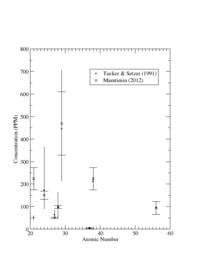 File:MLS-1 PAAresults.xmgrac.txt
File:MLS-1 PAAresults.xmgrac.txt
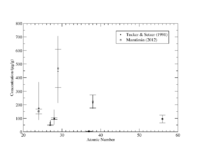
Evironmental Dust
Instrumental analytical methods are preferable in studying sub -milligram quantities of airborne particulates collected in dust filters. The multi-step analytical procedure used in treating samples through chemical separation can be quite complicated. Further, due to the minute masses of the airborne particulates collected on filters, such chemical treatment can easily lead to significant levels of contamination. Radio-analytical techniques, and in particular, activation analysis methods offer a far cleaner alternative. Activation methods require minimal sample preparation and provide sufficient sensitivity for detecting the vast majority of the elements throughout the periodic table. In this paper, we will give a general overview of the technique of photon activation analysis. We will show that by activating dust particles with 10- to 30-MeV bremsstrahlung photons, we can ascertain their elemental composition. The samples are embedded in dust-collection filters and are irradiated “as is” by these photons. The radioactivity of the photonuclear reaction products is measured with appropriate spectrometers and the respective analytes are quantified using multi -component calibration materials. We shall provide specific examples of identifying the elemental components of airborne dust particles and volcanic ash by making use of bremsstrah lung photons from an electron linear accelerator at the Idaho Accelerator Center in Pocatello, Idaho.
Equipment
WHite room pictures
Detectors
CVD diamond
Erich Griesmayer
http://www.cividec.at http://www.cividec.at/#products.html
Prof. Dr. Erich Griesmayer CIVIDEC Instrumentation GmbH Schottengasse 3A/1/41 A - 1010 Wien Mobile: +43 664 1066840 Fax: +43 1 9223619 www.cividec.at
BPMs
Bergoz Instrumentation:
S-BPM = $4080 Euros S-BPM-FEFA = $1260 Euros
the other accessories are also desired
File:Bergoz BPM PriceList 2012.pdf
Permanent magnet
Off the shelf
A M-25 5 kGauss permanent magnet with a footprint of 4" x 3" could be placed between the radiator and the isotope target on Jack.
http://www.mmr-tech.com/comp_electromagnets.php
The gap is 0.75" so it to would need to go in the vacuum. We would need to determine how much the beam spot blows up after leaving the converter and how high the photon flux is in the sample region after the 3" distance is taken up by the magnet.
Custom
The vendor below has stated that they have the ability to design a permanent magnet to our specification.
http://www.duramag.com/request-a-quote.html
The above vendor needs a CAD drawing showing the dimensions of a magnet that would work for isotope production on Jack in order to provide a quote.
need large quantity orders, not interested now in one custom magnet. Didn't think 1" face was possible.
jima@duramag.com
Transport system samples
http://www.intellitrak.com/Products.htm
http://www.intellitrak.com/Products-500.htm
http://www.asi.com/auto-industrial/overhead-conveyors/monorail.php
http://www.asi.com/bulk-material/
References
Nitrogen tracers: N-15 is rare. If you dope nitrogen sources with it you can see where the leak into environment. This is a stable tracer so it would be able to monitor long time plume expansions.
Catchment hydrology
Review of Diamond detectors
http://www.ifh.de/~akg/phys/tapper.pdf
Simulations
http://www.osti.gov/energycitations/product.biblio.jsp?query_id=1&page=0&osti_id=20658046
High Flux MeV photon profiler
http://accelconf.web.cern.ch/accelconf/p99/PAPERS/WEA90.PDF
http://ieeexplore.ieee.org/ielx5/5379507/5398121/05398374.pdf?tp=&arnumber=5398374&isnumber=5398121
CVD Diamond film
Film Vendor only
http://www.e6cvd.com/cvd/page.jsp?pageid=415
Alemeda Applied Sciences Corporation
http://www.aasc.net/drds http://www.aasc.net/media/DRD-AppNote.pdf
Diamond x-ray view screen http://www.diamond-materials.com/EN/products/cvd_for_xray/fluorescence_beam_monitors.htm
http://www.npl.co.uk/upload/pdf/091104_nuc_galbiati.pdf
NIM paper from 2002
http://144.206.159.178/ft/787/47160/14168748.pdf
Diamond Detectors LtD (Vendor for single crystal Chip on Board Package)
http://www.npl.co.uk/upload/pdf/091104_nuc_galbiati.pdf
Medical isotopes
Market report forcasting -> 2015
2013 DOE Medical Isotope program budget and info
2010 Talk on Future Isotope needs in medicine and industry
http://www.nscl.msu.edu/~mantica/radio-frib/runde-acsboston.pdf
Need Mo-99, Tc-99m, I-131, I-125, Cu-67, At-211, Ac-225, Bi-213, Am-241, Gd-148, Sr-90, Pm-147
A big isotope supplier is Eckert & Ziegler
http://www.ezag.com/fileadmin/ezag/user-uploads/pdf/analyses-englisch/concord_e_01.pdf
2009 Medical Isotope industry & trade study
http://www.usitc.gov/publications/332/ITS-1.pdf
Fracking
http://www.shalegas.energy.gov/resources/111811_final_report.pdf
Earth Justice
http://earthjustice.org/features/campaigns/fracking-across-the-united-states
http://www.drillingmaps.com/fracking.html#.UQq-QKUlZ6I
Injection of a wide range of radioactive tracers in solid, liquid or gaseous forms,<ref name="NRC"/> is often used to determine the injection profile and location of fractures created by hydraulic fracturing.<ref name="Reis iodine" /> The radiotracer is chosen to have readily detectable radiation, appropriate chemical properties, and a half life and toxicity level that will minimize initial and residual contamination.<ref name="IAEA 2003" />
The isotopes, Manganese-56, Sodium-24, Technetium-99m, Silver-110m, Argon-41, and Xenon-133 are used extensively in the oil industry because they are easily identified and measured.<ref name="IAEA 2003" /> Also Antimony-124, Bromine-82, Iodine-125, Iodine-131, Iridium-192, and Scandium-46 are used.<ref name="NRC"/>
In the United States radionuclides maximum amounts per injection are controlled by the United States Nuclear Regulatory Commission (NRC).<ref name="NRC"/> For example, Iodine-131, gas form, 100 millicuries total, not to exceed 20 millicuries per injection; Iodine-131, liquid form, 50 millicuries total, not to exceed 10 millicuries per injection; Iridium-192, "Labeled" frac sand, 200 millicuries total, not to exceed 15 millicuries per injection; Silver-110m, liquid form, 200 millicuries total, not to exceed 20 millicuries per injection.<ref name="NRC"/>
Na-24 is used for fracking as well... They are making it on site by (n,gamma) on Na-23, using neutron generators. Initial concentration of Na-24 is 0,24 mCi, volume of the solution is 2-3 m3; activity per volume is 0.08-0.12 mCi/m3.
Geology
2011 paper on PAA for environmental analysis
http://www.rrp.infim.ro/2011_63_2/art03Oprea.pdf
A 1988 paper measuring Flourine using PAA
http://www.tandfonline.com/doi/abs/10.1080/10256018808624007#preview
2007 paper studies PAA,NAA,PGA techniques for measuring Halogen in Geological samples
http://www.ncbi.nlm.nih.gov/pubmed/17878588
2007 comparison of PAA and NAA in geology
http://www.ingentaconnect.com/content/klu/jrnc/2007/00000271/00000003/00000311?crawler=true
1994 segebade article on optimizing PAA for environmental analysis
http://www.ncbi.nlm.nih.gov/pubmed/7710821
2009 measuring Sr/Ca in teeth can be useful for biology and archaeology
Potential collaborators
Alberto E. Patiño Douce
http://www.gly.uga.edu/patinoA/
Sune Nielsen
http://www.whoi.edu/profile.do?id=snielsen ( http://nsf.gov/awardsearch/showAward?AWD_ID=1119373)
Artificially-produced Isotope List
Jeff H. Shelton Isotope Business Office (IBO) National Isotope Development Center (NIDC) Telephone: (865) 576-6401 E-mail: EF6 or sheltonjh@ornl.gov
Cobalt-60, Lanthanum-140, Scandium-46, Silver-110m, Gold-198: Used together in blast furnaces to determine resident times and to quantify yields to measure the furnace performance.
cross section data base
http://cdfe.sinp.msu.ru/services/
http://www-nds.iaea.org/photonuclear/
http://www-nds.iaea.org/photonuclear/app-b2.pdf
Industrial
- Using targets with natural isotope abundance larger than 20 %
| Isotope | Production Reaction | Target nat. Abund | X sect | Use |
| Cesium-137 | 72% | Used for radiotracer technique for identification of sources of soil erosion and deposition, in density and fill height level switches. | ||
| Cobalt-60 | 1 % | Used for gamma sterilisation, industrial radiography, density and fill height switches. | ||
| Gold-198 | 16.9% | Used to study sewage and liquid waste movements, as well as tracing factory waste causing ocean pollution, and to trace sand movement in river beds and ocean floors. | ||
| Iodine-131 | 27% | adioactive tracer isotopes are injected with hydraulic fracturing fluid to determine the injection profile and location of fractures created by hydraulic fracturing | ||
| Iridium-192 | 63% | Fracking ,Used in gamma radiography to locate flaws in metal components. | ||
| Zinc-65 | 28% | pg 56 | Used to predict the behaviour of heavy metal components in effluents from mining waste water. | |
| Scandium-47 | 74% | pg 133 |
|- | Tl-201 || || Medical Thalilum is most common substitute for Tc |- | Cu-67 || || 19% || |-
Rh-99
Ti-44
Pd-100
Ag-111
Hf-181
Bi-204
Cs-131, Silver-110, Indium-111, Ga-67, Bromine-77, Fl-18, O-15, Al-26, N-13, Scandium-47, Ba-133
Tt-195 -> Ir-194
| Isotope | Production Reaction | Use |
| Am-241 | Used in backscatter gauges, smoke detectors, fill height detectors and in measuring ash content of coal. | |
| Cesium-137 | (72%) | Used for radiotracer technique for identification of sources of soil erosion and deposition, in density and fill height level switches. |
| Chromium 57 | Used to label sand to study coastal erosion. | |
| Cobalt-60 | Used for gamma sterilisation, industrial radiography, density and fill height switches. | |
| Gadolinium-148 | ||
| Gold-198 | (16.9%) | Used to study sewage and liquid waste movements, as well as tracing factory waste causing ocean pollution, and to trace sand movement in river beds and ocean floors. |
| Iodine-131 | (27%) | adioactive tracer isotopes are injected with hydraulic fracturing fluid to determine the injection profile and location of fractures created by hydraulic fracturing |
| Iridium-192 | (63%) | Fracking ,Used in gamma radiography to locate flaws in metal components. |
| Krypton-85 | Used for industrial gauging. | |
| Manganese-54 | Used to predict the behaviour of heavy metal components in effluents from mining waste water. | |
| Nickel-63 | Used in light sensors in cameras and plasma display, also electronic discharge prevention and in electron capture detectors for thickness gauges. | |
| Pm-147 | ||
| Selenium-75 | Used in gamma radiography and non-destructive testing. | |
| Strontium-90 | Used for industrial gauging | |
| Technetium-99m | Used to study sewage and liquid waste movements, as well as tracing factory waste causing ocean pollution, and to trace sand movement in river beds and ocean floors. | |
| Thallium-204 | Used for industrial gauging. | |
| Ytterbium-169 | Used in gamma radiography and non-destructive testing. | |
| Zinc-65 | (28%) | Used to predict the behaviour of heavy metal components in effluents from mining waste water. |
Medical
Cesium-137 || || Used for radiotracer technique for identification of sources of soil erosion and deposition, in density and fill height level switches.| Isotope | Production Reaction | Use | |
| Mo-99 | Medical | ||
| Tc-99m | Medical | ||
| Tl-201 | Medical Thalilum is most common substitute for Tc | ||
| I-131 | |||
| I-125 | |||
| Cu-67 | 19% | ||
| Ac-225 | |||
| Bi-213 | |||
| Am-241 | Used in backscatter gauges, smoke detectors, fill height detectors and in measuring ash content of coal. | ||
| Gd-148 | |||
| Sr-90 | |||
| Pm-147 | |||
| F-18 | Medical, aka FDG flourodeoxyglucose used in 90% of PET imaging, proton accelerator does | ||
| Ga-67 | Medical | ||
| Re -186 | Medical | ||
| I-123 | Medical | ||
| Sm -153 | Medical | ||
| Y-90 | Medical | ||
| Er-169 | Medical | ||
| Y-88 | |||
| Sc-44 | |||
| Ir-192 | implanted to irradiate tumors |
Vendors
Perkinelmer
http://www.perkinelmer.com/Catalog/Category/ID/Radionuclides
Isoflex
http://www.isoflex.com/isotopes/ir192.html
ZeroWash Tracers
http://www.corelab.com/pe/protechnics/Tracers/ZeroWash.aspx
